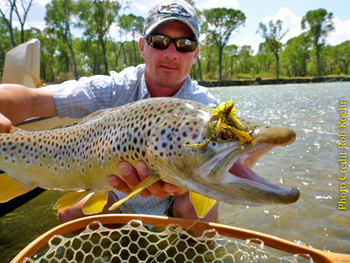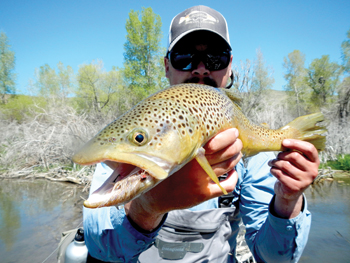Sink Tips Demystified
With football season getting started and the nights growing cooler, it appears that summer is winding down. While there is still plenty of dry fly fishing to be had in September, fall inevitably brings to mind streamer fishing for brown trout with colors as bright as the trees we fish beneath.
A very important, but rather confusing part of streamer fishing is the use of sink tip lines. Sink tips are the marriage of traditional floating line and sinking line. The styles of sink tips vary greatly and consequently can leave some people scratching their head when trying to decide which fly line to put on their streamer rod.
The biggest factor when picking your sink tip line is the sink-rate. Fly line companies use a few different ways to list sink rates. For example, Rio Products uses the terms Intermediate, Type 3, and Type 6 to represent lines that sink 2 inches per second, 3 inches per second and 6 inches per second respectively. Another common way to list sink rates is with grain weights. Generally 150 -160 grains is ideal for a 5 weight rod and grain weight can go all the way up to 400 grains for 10 weight rods; basically the heavier the weight, the faster the sink.
When deciding how fast you want your line to sink, you should first look at the type of water you want to fish. If you plan on fishing the Lower Madison an Intermediate sink tip is more than enough. If you are fishing the Yellowstone during spring runoff a 400 grain sink tip isn’t overkill, in fact it can be necessary to get your fly where the fish are. In general, 3-4 inches per second is a great all around sink rate. If you overweight your sink tip and go to heavy, you’ll know it. The first thing you’ll notice is that you will strip line faster than necessary in order to keep your fly off the bottom. As a general rule, you don’t want the line to dictate your retrieve speed.
The next step is determining the desired taper. Tapers directly effect how your rod casts. As with floating lines, the more aggressive the taper, the easier it is to load a fast action rod. Some sink tips have a flat taper until you get to the floating section where the main taper starts. These fly lines are meant to be cut back to the desired length so that you won’t cut into the taper of the fly line while adjusting the sink tip section. Other fly lines have the sink section built into the taper. This allows you to cut back into your taper and give yourself a more aggressive line with a shorter sinking section – ideal for loading your rod on smaller water with shorter casts.
Another option is Airflo’s Streamer Max. This fly line is sold in grain weights, but the unique aspect of it is that they have built the line to go from floating, to intermediate sink, to full sink. This eliminates the “hinge” that you get when your line goes from floating directly to heavy sink and gives you a uniformed sink rate while improving line pick up at the end of your retrieve.
Finally, you can go the route of detachable sink tip leaders. These come in 5 or 10 feet and loop directly to the end of your floating line, essentially turning a floating line into a sink tip line. The benefits being that you don’t need to purchase two fly lines and the negative aspect being that you have a hinge where your leader attaches to the fly line creating an awkward cast.
Why should you fish a sink tip with your streamers? First of all, you can get your flies down deeper, faster. This is especially important when fishing from a boat as you only get one or two shots to put your fly in front of the fish. It also allows you to fish un-weighted flies which have more natural movement in the water and are easier to throw than heavily weighted flies. Nymph fishermen also use sink tips to get nymph rigs deep when fishing high, turbulent water.
Why not fish a full sink line? These are great on lakes or deep slow water but with no floating section, you can’t mend or pick line up as effectively as with a sink tip.
The transition into sink tips can be an awkward one – personally I had a few close calls myself while learning. Starting with an intermediate sink rate will help curb the learning period and will make you comfortable moving into the faster, heavier sink rates.
So this fall, when the mornings get crisp and the leaves start turning, put away the dry fly rod, pick up your streamer stick, and get some meat down deep where the big dogs hang.
Jake Adelman is the General Manager at Montana Troutfitters and an alumni of MSU. You can find more of his thoughts on fishing at www.troutfitters.com.
